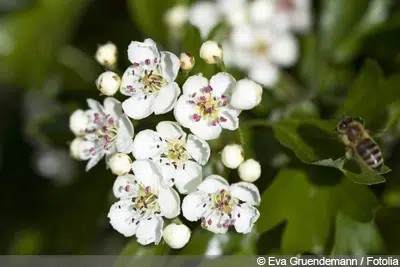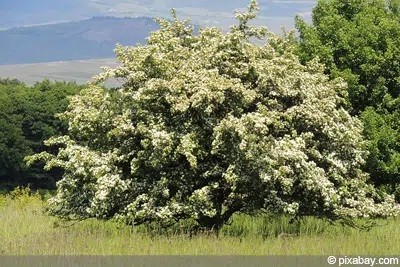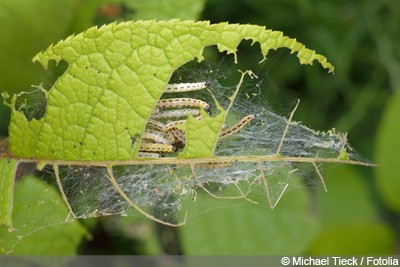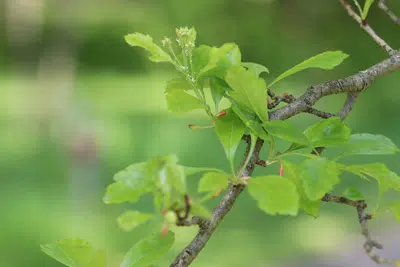Hawthorns (Crataegus) are popular shrubs or small trees for gardens, mostly natural gardens. There are about 200 to 300 species, but in Europe there are only a good 20, in Europe even only three. These are very similar and can hardly be distinguished by a layman. They are the common hawthorn (Crataegus monogyna), the twiggy hawthorn (C. laevigata) and the large-clawed hawthorn (C. curvisepala).
Contents
Why hawthorn is so popular
Hawthorn is a popular hedge plant for free-growing hedges. Especially birds are pleased with these plants. They breed in the thorny branches, where they are well protected from most predators. In addition, the berries of hawthorn are edible, not only for birds. You can make compote and jelly from them or mix them with other fruits. Hawthorn is very well tolerant to pruning, which is why it also makes a good hedge plant. The only disadvantage of pruning is that the flowering is not so abundant, because the flowers appear only on the perennial wood.
Growth and flowering
The hawthorn grows strongly branched and can grow several meters high. It blooms in umbels between April and May. The flowers emit a pleasant fragrance that attracts insects in particular. Between August and September, the small red, apple-like fruits appear. They remain attached to the wood for a long time, often surviving the winter.
Hawthorns with double flowers are especially beautiful. Asian and North American species are also popular ornamental shrubs. They shine with larger fruits and more intense fall color, but are not as attractive to most native bird species in purely foraging terms. The hawthorn is usually used for hedges. It is best pruned into shape. Unpruned, it reaches heights of 2 to 5 meters. Its annual growth is 20 to 40 cm per year.
Attention – fire blight
All hawthorn shrubs have one major disadvantage. They are susceptible to fire blight, a dangerous disease that is even reportable. The pathogen is a bacterium that spreads rapidly. There are numerous ways of infection. Fire blight can be recognized by the fact that leaves and flowers suddenly wilt from the petiole and turn brown or even black. Shoot tips bend downward in a hooked shape. The plant looks like it has been burned, hence the name fire blight. In addition, bacterial slime escapes from the infection sites.
Fire blight is reportable, to the state office or the state department of agriculture. Destruction can be ordered, of all highly susceptible or infested plants located in a quarantine zone. Beekeeping is usually prohibited. In most cases, only grubbing up helps. Research is currently underway to find resistant species and varieties.

Hawthorn – care
Hawthorn is very undemanding and easy to care for, the ideal garden woody plant, except for fire blight. The woody plant is very tolerant of heat and created for absolutely sunny locations. The hawthorn also has no problem with salt-laden winds and thrives near salt water. Ideal companions of the hawthorn are wild roses, blackthorn, buckthorn, barberry, privet, hazel, red dogwood, hornbeam and black elder.
Location
The hawthorn likes the sun. It prefers a full sun location. It also tolerates heat stress and does much better with sun than with shade. A slightly semi-shaded location is also tolerated. However, it does not like too much shade, although these woody plants are also touted as shade tolerant.
- Sunny location
- Partial shade is tolerated
- Tolerates heat and heat stress
- Very wind resistant
- Planting substrate
To the planting substrate hawthorn does not require much. It thrives in almost any soil. They should not be too wet, but otherwise it can cope with anything.
- No special demands on the soil
- Normal garden soil is sufficient
- Medium to light soils are preferred.
- They should be neutral to slightly alkaline.
- PH value – 6.0 to 8.0
- Very acidic soils are unsuitable.
- Poor development on dry, nutrient-poor soils.
- Sensitive to soil compaction
Planting
There is nothing special to consider when planting. The best time for planting the hawthorn is autumn. The soil should be well enriched with nutrients. The planting hole must be sufficiently deep and provide space. It is important to pay attention to planting distances. It is best to buy bare-root plants. It is recommended to buy and plant hawthorns as young as possible. Older specimens usually grow poorly.
- Planting time is autumn, before the first frosts or in spring.
- Before planting, loosen soil well and enrich with natural fertilizer (compost, horn shavings, manure) (best 14 days before planting).
- Pralinate bare-root woody plants before planting. To do this, immerse the roots in a mixture of water and peat for 30 minutes. It is advisable to add some fertilizer to this mixture. Then place the tree in the planting pit. It is important not to squeeze the roots. Cover the root properly with soil.
- If baling, place the root ball in the pit, loosen the cloth and remove wires if necessary. Bale cloths are biodegradable and can be left in the pit.
- Containerized stock is the easiest to plant. Remove the hawthorn from the container, carefully untangle the roots with your fingers, insert the plant, and pour on soil.
- In each case, gently press the soil down with both feet. If too much empty space is left, the roots will be at risk of rotting from accumulating water during subsequent watering. But if you press too hard, the roots are in danger of suffocation.
- Water vigorously after planting
- When planting hedges, leave enough space, planting distance – three plants per meter.

Watering and fertilizing
The hawthorn is not very demanding. It copes quite well with drought, but sometimes loses part of its leaves. If the soil is often too dry, it weakens the tree or bush. It becomes more susceptible to diseases and pests. It is better to water occasionally during drought. Older trees handle drought better. The hawthorn is a deep-rooted tree, it absorbs water from the depths. However, to penetrate to this depth, the woody plant needs a few years. Fertilizing is not necessary. Only the incorporation of some compost in the spring makes sense.
- Do not let the root ball dry out completely
- Especially young woody plants need a little more water.
- After growing, the plants take care of themselves as far as possible.
- No additional fertilizer necessary
- Too much fertilizer is actually harmful. It reduces the formation of flowers.
Pruning
The hawthorn is absolutely tolerant of pruning. Therefore, it can also be used as a hedge plant. However, it will never reach its full beauty, because every time you cut it, you are cutting away the blossoms. It is better to let the hedge grow and not to cut it. For this, of course, space is needed.
- Very tolerant of pruning
- Grows especially vigorously after pruning
- Do not prune for the first two to three years
- It is best to cut before budding
- Also possible after flowering or during the growing season
- Carry out heavy pruning with appropriate tools
- If you want to raise a tree, the low side branches must be removed.
- In the fall or winter, prune to achieve a crown. This must be thinned out to allow more light in.
- Do not cut during frost!
- Hedge plants are best trimmed in June.
- The easiest way to maintain the hedge is to trim it smoothly every two years.
Wintering
Wintering is not a problem. Hawthorn is exceptionally hardy and has no problems with cold, ice or snow.
Propagate
Propagation works in different ways, by seeds, by cuttings, by grafting and you can propagate hawthorn by cuttings, which is the most common way. During research I found out that cuttings and cuttings do not work so well. Seeding, however, succeeds reliably.
- Cuttings propagation – in spring, cut a 4 to 8 cm piece of this year’s wood above a node. There must be at least one leaf and one bud on the cutting. Plant the cutting 1/3 of the way in. Keep moist, preferably cover with a bag. Do not forget to ventilate
- Cuttings – in February, cut strong one-year-old shoots (just below one eye), about 20 cm long and not too soft and not yet fully mature. Stick 2/3 to ¾ into substrate. Place warm and keep slightly moist
- Grafting – is usually done by a professional.
- Pure species can be propagated by sowing.
- The seeds are cold germinators.
- If fruits are left in the garden, many small seedlings often sprout in the spring.
Diseases and pests
Hawthorn is related to many fruit trees. Therefore, it also harbors fruit pests.
- Powdery mildew – milky coating – work rock flour into the soil as a preventative (once a year), use fungicide in case of infestation.
- Scab (fungal disease) – recognizable by brownish spots and cracks on leaves, flowers and fruits. Plants are weakened and often die. Prevention can be done by pruning. The branches must not be too close together. Cut off diseased parts and dispose of them in household waste. Sulfur provides a remedy.
- Spider moth – mainly attacks apple trees. The hawthorn serves as an alternative shelter, relieves the fruit trees. To be controlled by birds and ichneumon wasps.
- The same happens with codling moth, blood louse, golden aphid and apple moth.
- Hawthorn rust – pathogen is a rust fungus that overwinters on juniper. It re-infects the hawthorn every year. The fungus can be recognized by thickenings on the branches, where brown, later yellow spore deposits appear in April. Entire twig sections may be colored orange. In addition, orange-red spots appear on the upper surfaces of the leaves from mid-May. Leaf veins and petioles thicken. Prevention – spatial separation of hawthorn and juniper. Check juniper regularly for infestation. In the case of hawthorn, use means of control, e.g. systemic means or those with contact action.
- Fire blight

Conclusion
The hawthorn is a popular woody plant for the garden. It is especially popular as a hedge plant. A free-growing hedge develops particularly beautifully without major pruning measures. However, this becomes very wide. You have to have the space first. For me, half the garden would be gone. Otherwise, hawthorn is easy to care for. Only with the fire blight there are problems. But it is not widespread everywhere. If you plan to plant a hawthorn or a red hawthorn, you should find out if you live in such a risky area. If so, it is not advisable. Otherwise, it is safe to plant this tree. After all, there are no guarantees for anything in life.










